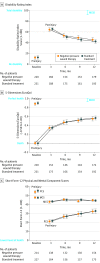Effect of Negative Pressure Wound Therapy vs Standard Wound Management on 12-Month Disability Among Adults With Severe Open Fracture of the Lower Limb: The WOLLF Randomized Clinical Trial
- PMID: 29896626
- PMCID: PMC6583504
- DOI: 10.1001/jama.2018.6452
Effect of Negative Pressure Wound Therapy vs Standard Wound Management on 12-Month Disability Among Adults With Severe Open Fracture of the Lower Limb: The WOLLF Randomized Clinical Trial
Abstract
Importance: Open fractures of the lower limb occur when a broken bone penetrates the skin. There can be major complications from these fractures, which can be life-changing.
Objectives: To assess the disability, rate of deep infection, and quality of life in patients with severe open fracture of the lower limb treated with negative pressure wound therapy (NPWT) vs standard wound management after the first surgical debridement of the wound.
Design, setting, and participants: Multicenter randomized trial performed in the UK Major Trauma Network, recruiting 460 patients aged 16 years or older with a severe open fracture of the lower limb from July 2012 through December 2015. Final outcome data were collected through November 2016. Exclusions were presentation more than 72 hours after injury and inability to complete questionnaires.
Interventions: NPWT (n = 226) in which an open-cell solid foam or gauze was placed over the surface of the wound and connected to a suction pump, creating a partial vacuum over the dressing, vs standard dressings not involving application of negative pressure (n = 234).
Main outcomes and measures: Disability Rating Index score (range, 0 [no disability] to 100 [completely disabled]) at 12 months was the primary outcome measure, with a minimal clinically important difference of 8 points. Secondary outcomes were complications including deep infection and quality of life (score ranged from 1 [best possible] to -0.59 [worst possible]; minimal clinically important difference, 0.08) collected at 3, 6, 9, and 12 months.
Results: Among 460 patients who were randomized (mean age, 45.3 years; 74% men), 88% (374/427) of available study participants completed the trial. There were no statistically significant differences in the patients' Disability Rating Index score at 12 months (mean score, 45.5 in the NPWT group vs 42.4 in the standard dressing group; mean difference, -3.9 [95% CI, -8.9 to 1.2]; P = .13), in the number of deep surgical site infections (16 [7.1%] in the NPWT group vs 19 [8.1%] in the standard dressing group; difference, 1.0% [95% CI, -4.2% to 6.3%]; P = .64), or in quality of life between groups (difference in EuroQol 5-dimensions questionnaire, 0.02 [95% CI, -0.05 to 0.08]; Short Form-12 Physical Component Score, 0.5 [95% CI, -3.1 to 4.1] and Mental Health Component Score, -0.4 [95% CI, -2.2 to 1.4]).
Conclusions and relevance: Among patients with severe open fracture of the lower limb, use of NPWT compared with standard wound dressing did not improve self-rated disability at 12 months. The findings do not support this treatment for severe open fractures.
Trial registration: isrctn.org Identifier: ISRCTN33756652.
Conflict of interest statement
Figures


Comment in
-
Negative Pressure Wound Therapy for Open Fractures.JAMA. 2018 Oct 23;320(16):1709. doi: 10.1001/jama.2018.11747. JAMA. 2018. PMID: 30357287 No abstract available.
References
Publication types
MeSH terms
Associated data
Grants and funding
LinkOut - more resources
Full Text Sources
Other Literature Sources

